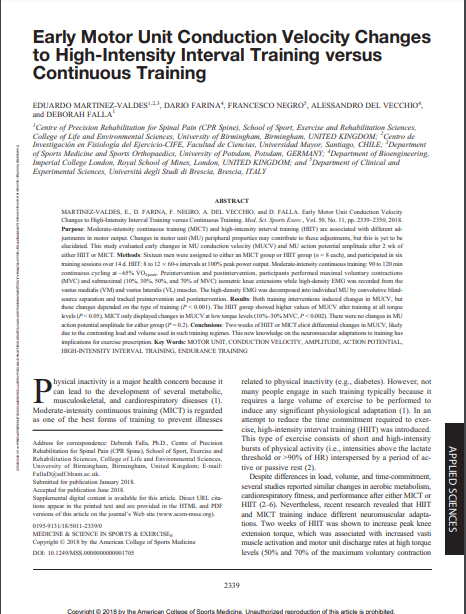Early Motor Unit Conduction Velocity Changes to High-Intensity Interval Training versus Continuous Training

Fecha
2018Autor
Martínez-Valdés, Eduardo [Univ Mayor, Ctr Invest Fisiol Ejercicio CIFE, Santiago, Chile]
Farina, Dario
Negro, Francesco
Del Vecchio, Alessandro
Falla, Deborah
Ubicación geográfica
Notas
HERRAMIENTAS
Acceda a títulos restringidos
¿Cómo descargar?Resumen
Purpose Moderate-intensity continuous training (MICT) and high-intensity interval training (HIIT) are associated with different adjustments in motor output. Changes in motor unit (MU) peripheral properties may contribute to these adjustments, but this is yet to be elucidated. This study evaluated early changes in MU conduction velocity (MUCV) and MU action potential amplitude after 2 wk of either HIIT or MICT. Methods Sixteen men were assigned to either an MICT group or HIIT group (n = 8 each), and participated in six training sessions over 14 d. HIIT: 8 to 12 x 60-s intervals at 100% peak power output. Moderate-intensity continuous training: 90 to 120 min continuous cycling at similar to 65% VO2peak. Preintervention and postintervention, participants performed maximal voluntary contractions (MVC) and submaximal (10%, 30%, 50%, and 70% of MVC) isometric knee extensions while high-density EMG was recorded from the vastus medialis (VM) and vastus lateralis (VL) muscles. The high-density EMG was decomposed into individual MU by convolutive blind-source separation and tracked preintervention and postintervention. Results Both training interventions induced changes in MUCV, but these changes depended on the type of training (P < 0.001). The HIIT group showed higher values of MUCV after training at all torque levels (P < 0.05), MICT only displayed changes in MUCV at low torque levels (10%-30% MVC, P < 0.002). There were no changes in MU action potential amplitude for either group (P = 0.2). Conclusions Two weeks of HIIT or MICT elicit differential changes in MUCV, likely due to the contrasting load and volume used in such training regimes. This new knowledge on the neuromuscular adaptations to training has implications for exercise prescription.
URI
https://doi.org/10.1249/MSS.0000000000001705http://repositorio.umayor.cl/xmlui/handle/sibum/6184
Coleccion/es a la/s que pertenece:
Si usted es autor(a) de este documento y NO desea que su publicación tenga acceso público en este repositorio, por favor complete el formulario aquí.